Trout might seem like a pretty basic fish, but there are actually numerous species of these freshwater creatures that come in many different shapes and sizes.
Trout fishing is popular among anglers for many reasons. They are a common fish that you might sometimes spot from the shore, due to their tendency to rise near the surface to catch bugs or baitfish. Trout can also reach impressive sizes. So just how big can these freshwater fish grow? That all depends on the type of trout.
Apache Trout (Oncorhynchus apache)
The Apache trout is the state fish of Arizona and are native to the area. This species makes its home in the state’s high-elevation streams but they have also been introduced into several lakes in the area. They are often bright yellow in color with medium-sized spots.
Mature Apache trout have an average length of 5-9 inches. Though they are typically not very large, they may grow to weigh as much as 5 pounds (the same weight as a two-liter bottle of soda) in their native headwater streams.

The Apache trout is the state fish of Arizona.
©Mariusz S. Jurgielewicz/Shutterstock.com
Brook Trout (Salvelinus fontinalis)
Brook trout, also known as speckled trout, are beautiful olive-green fish with yellow spots on their back. They are native to the United States and Canada.
According to Fish Masters, brook trout are a relatively small species that typically only weigh 1-2 pounds. Their average length is 10-11 inches. Despite their name, brook trout are not actually true trout. Dr. J.W. Cook caught the largest brook trout on record on July 21, 1915, in Ontario’s Nipigon River. The beast weighed over 14 pounds.
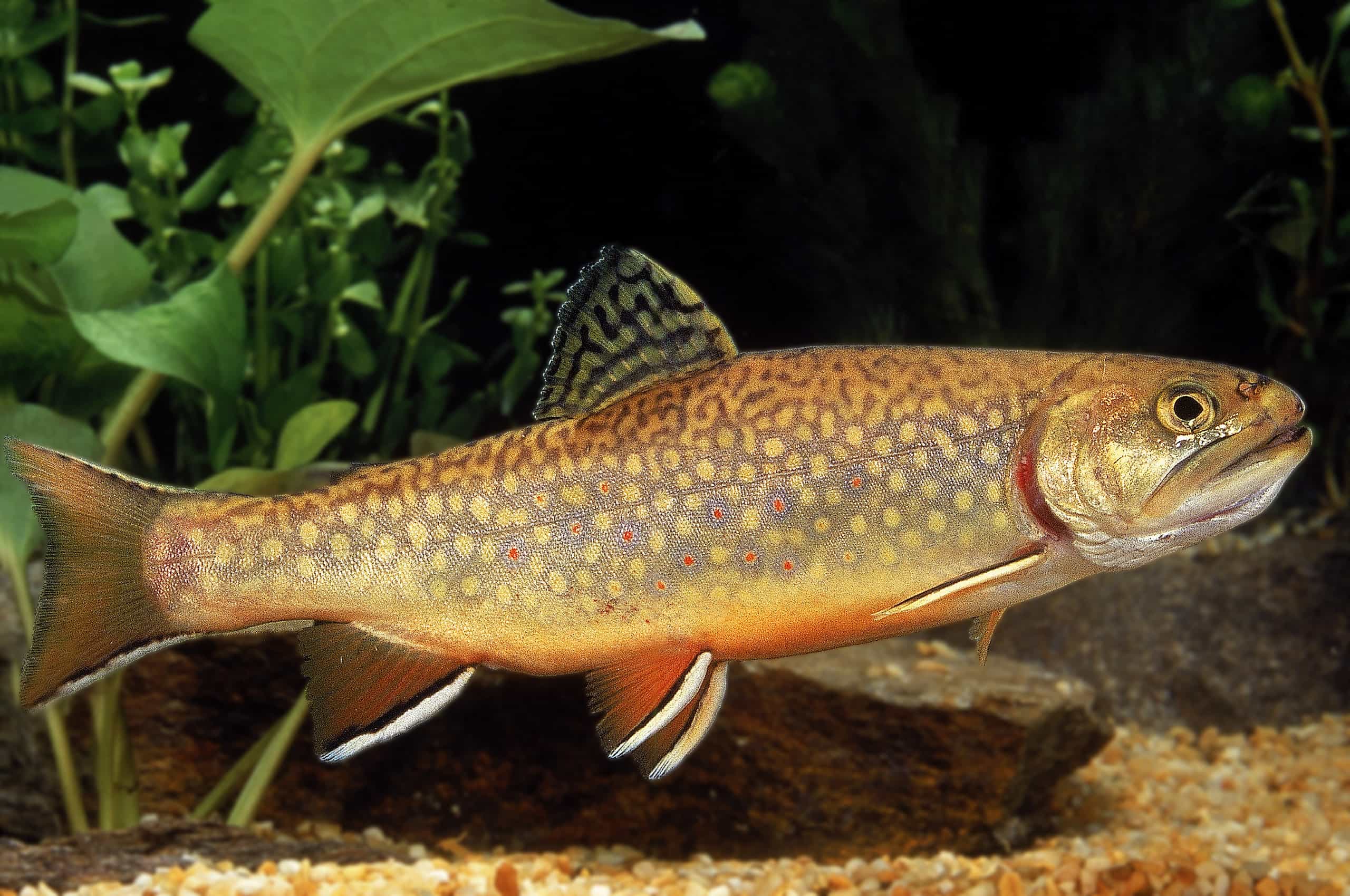
The brook trout has a speckled appearance, which fades if they spend time in salt water.
©Slowmotion GLI/Shutterstock.com
Brown Trout (Salmo trutta)
Brown trout are considered native to Iceland, Europe, western Asia, and northwestern Africa, though they were eventually introduced into North America. Today, brown trout call every major continent home except Antarctica.
Since brown trout are a medium-sized, non-native, and dominant predatory fish they can sometimes become invasive in certain areas. Brown trout can grow as large as 44 pounds or more and reach lengths of 39 inches in some areas. In some habitats, however, it’s common for brown trout to be smaller than 2 pounds.
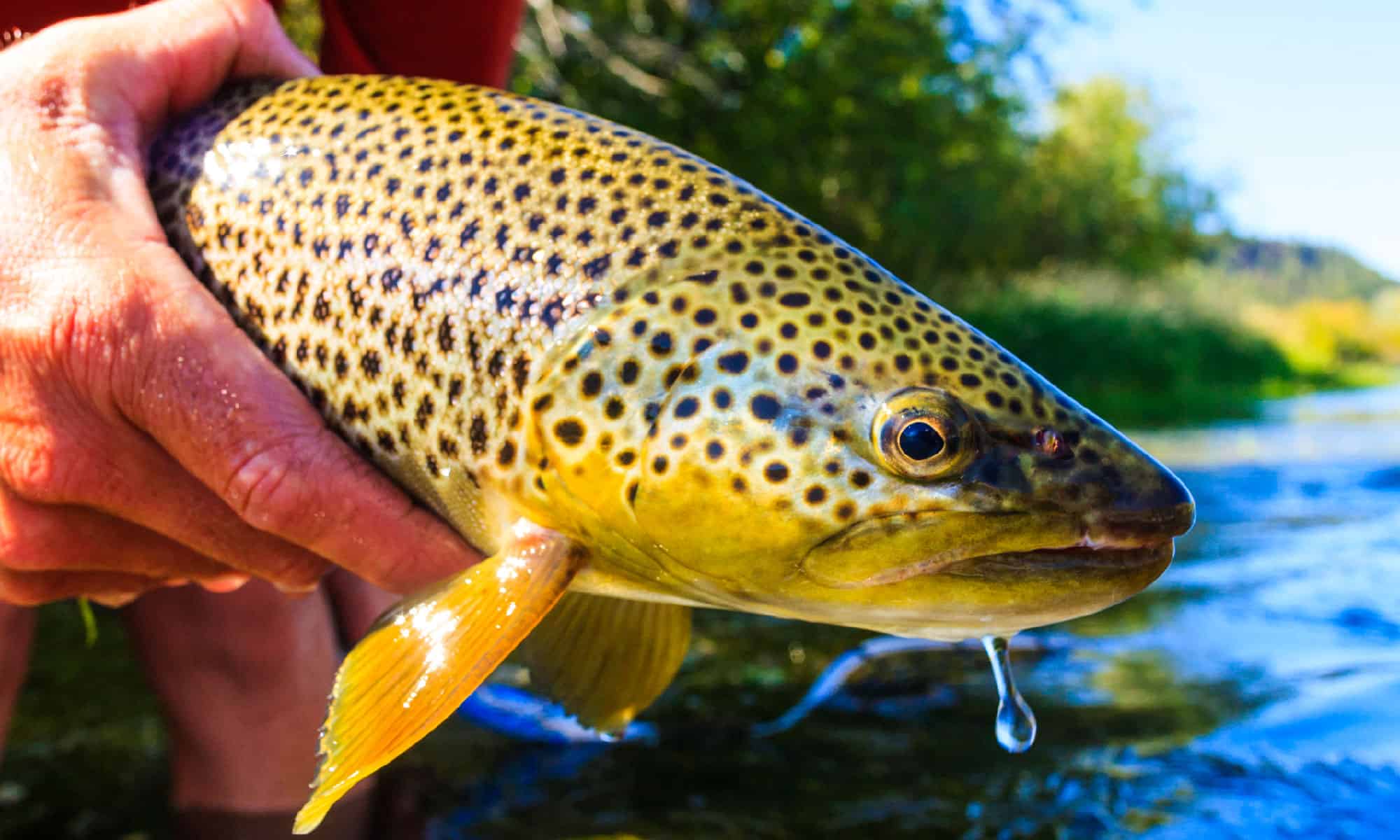
Brown trout can grow as large as 44 pounds.
©iStock.com/KevinCass
Bull Trout (Salvelinus confluentus)
Bull trout are another species that are not actually true trout. This species lives in rivers and lakes in the northwestern United States and northwestern Canada.
Bull trout have a very forked tail and tend to be larger in size. According to Bull Trout Dimensions, bull trout have an average length between 24-34 inches. Typically their weight ranges between 3-9 pounds. The record-breaking bull trout, caught in Idaho’s Lake Pend Oreille in 1949, weighed 32 pounds and was 40.50 inches long. That’s about the same weight as four gallons of water!
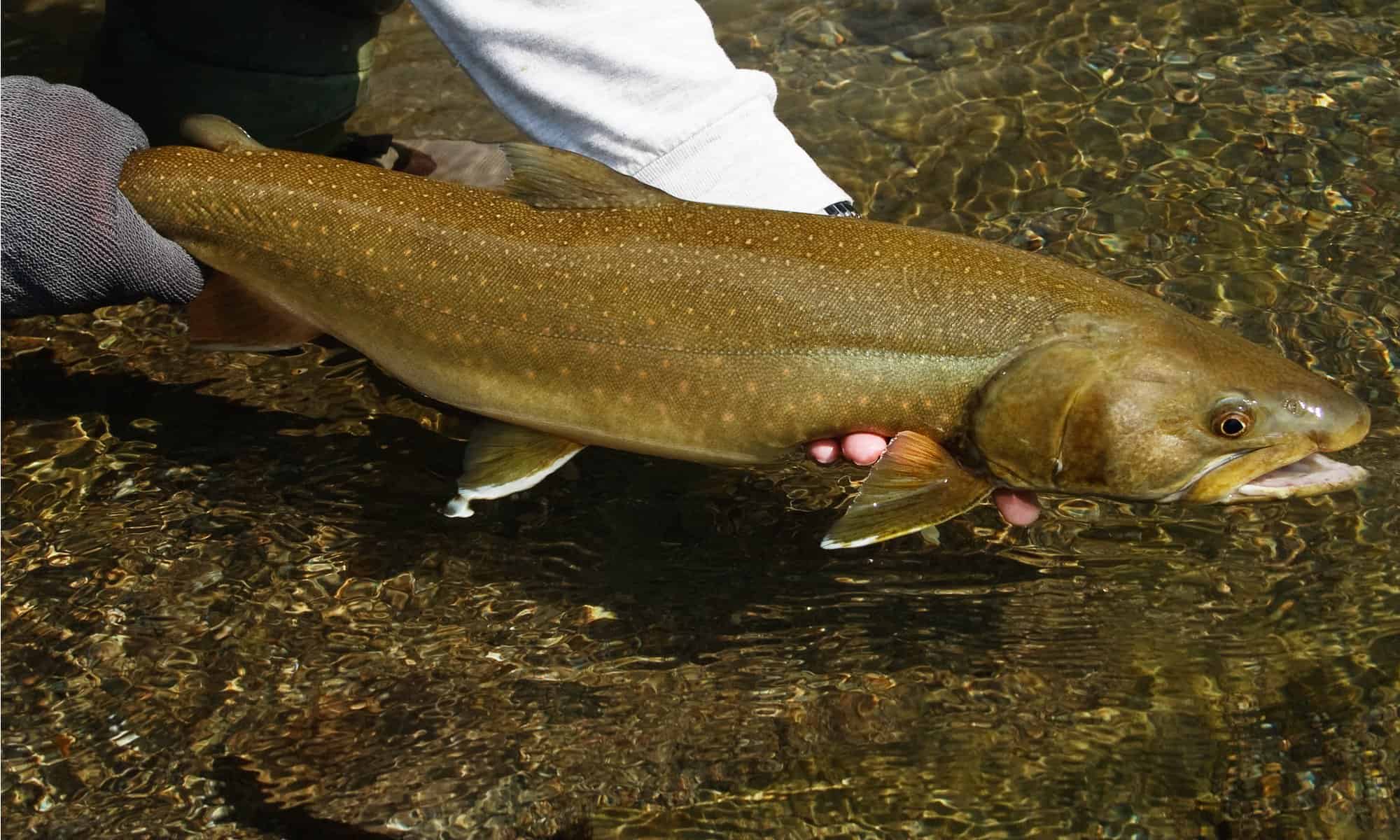
Bull Trout are large fish with a very forked tail.
©Streamside Adventures/Shutterstock.com
Cutthroat Trout (Oncorhynchus clarki)
Cutthroat trout are fascinating gamefish with as many as 14 recognized subspecies. They make their homes in cold water tributaries of the Great Basin, Rocky Mountains, and the Pacific Ocean.
Cutthroat trout range in color from golden to gray to green. Most subspecies of cutthroat trout have distinctive red, pink, or orange linear marks in the lower folds of their gill plates. These markings earned them their distinctive nickname.
The size of cutthroat trout depends on their location, but on average, mature sizes range from 6-22 inches and 4 ounces – 6 pounds, according to the Natural Resources Conservation Service (NRCS).

Cutthroat trout typically have distinctive marks on the lower folds of their gill plates.
©iStock.com/christiannafzger
Dolly Varden Trout (Salvelinus malma)
Dolly Varden trout are in the Salmonidae family along with other species such as Arctic char. The Dolly Varden trout get their name from a Charles Dickens character known for her rosy complexion. This species of fish tend to have brilliant red or orange spots on top of a dark grey, brown, or orange background.
Their average length is 9-27 inches and their average weight is between 0.5-19 pounds, according to the Animal Diversity Web. Mike Curtiss caught the biggest ever Dolly Varden trout on the Wulik River. It weighed 27 pounds, 6 ounces, and was 40 inches long.
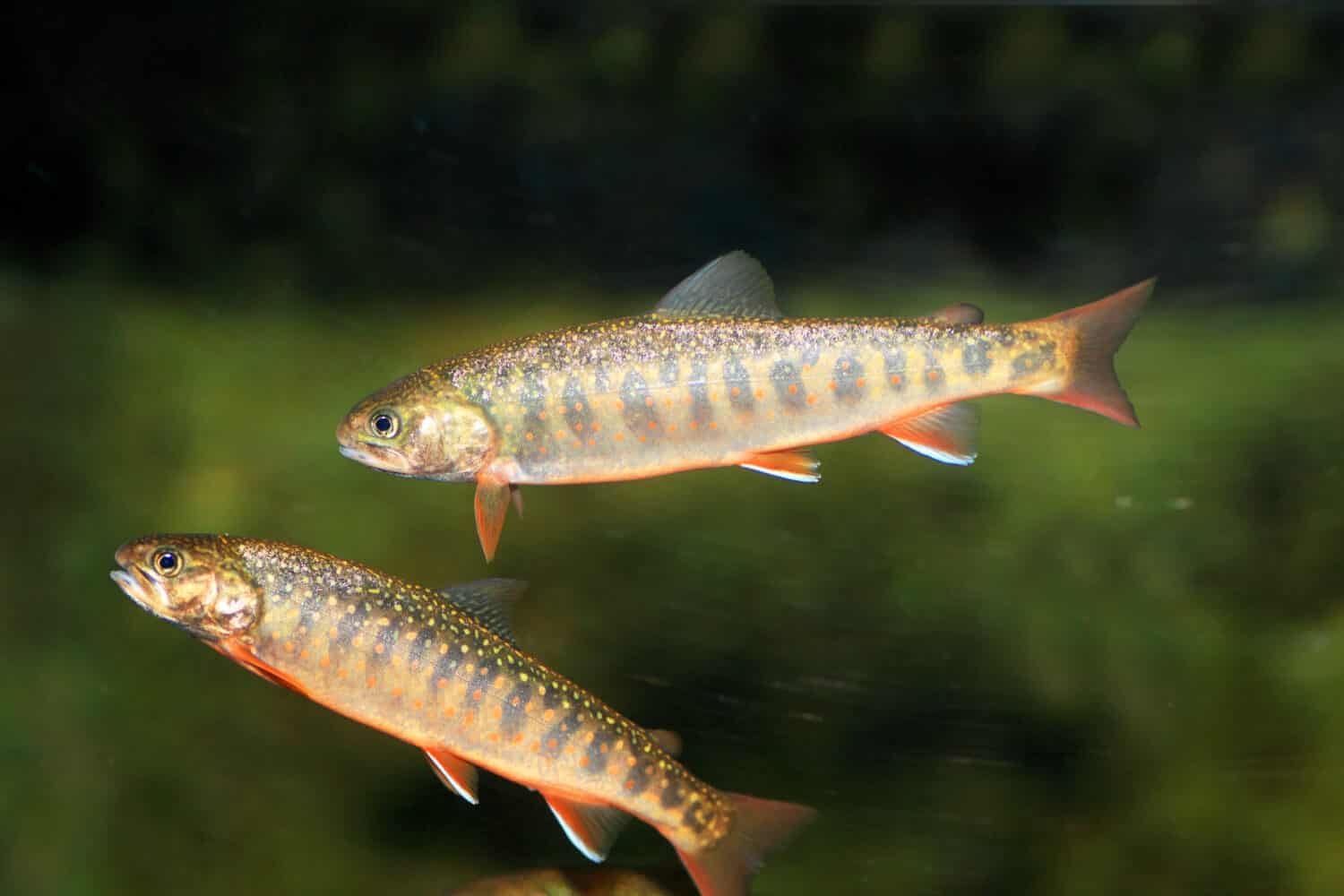
Dolly Varden trout are named after their brilliant red or orange spots.
©feathercollector/Shutterstock.com
Gila Trout (Oncorhynchus gilae)
The Gila trout gets its name from its native home in the tributaries of the Gila River in Arizona and New Mexico. These fish vary in color from yellowish brown to gold or copper.
Prior to 2006, they were listed as an endangered species, but the Gila trout was downlisted to “threatened” thanks to extensive efforts to restore their population. Still, only limited sport fishing is allowed for Gila trout. On average, these fish reach a length of around 11.8 inches, though the largest ever caught is just over 20 inches.
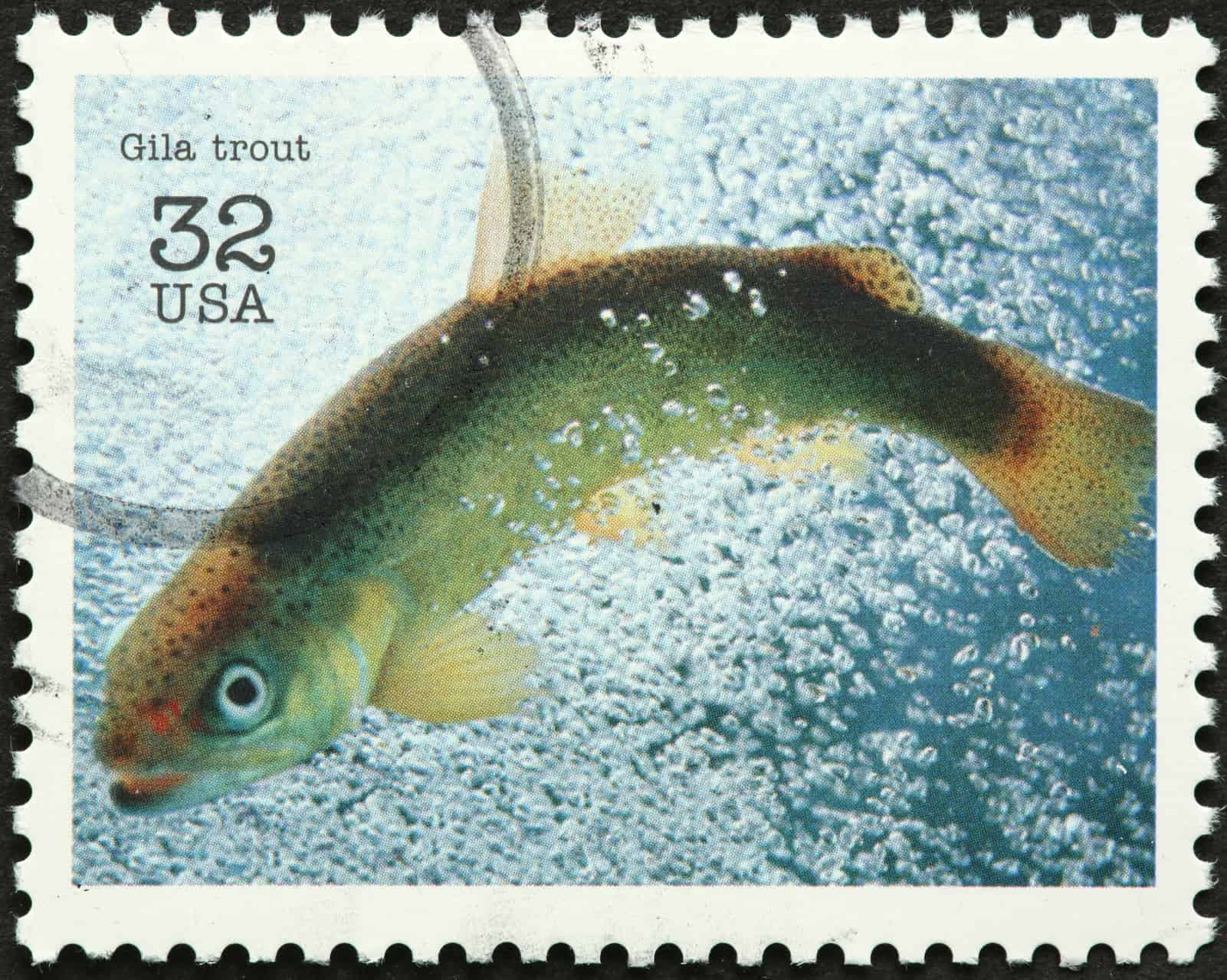
Gila trout are an endangered species.
©iStock.com/raclro
Golden Trout (Oncorhynchus aguabonita)
The California golden trout is the official state freshwater fish of California. With its vibrant colors, many consider the golden trout the most beautiful trout in the world.
They are typically found in several creeks in California, as well as the South Fork Kern River. Adults range from 6-12 inches and weights of up to 11 pounds have been recorded. That’s around the weight of an average adult house cat!

Golden trout are the official state freshwater fish of California.
©Aleksandra_Chukcha/Shutterstock.com
Lake Trout (Salvelinus namaycush)
Lake trout are the biggest species of the char family. They prefer cold, deep waters and are native to Canada and Alaska, the Great Lakes, and the Northeastern portion of the U.S.
They are typically brown or olive-gray with yellowish or white spots. Lake trout reach an average length of 18-20 inches and it is not uncommon for them to weigh between 15-40 pounds.

Lake trout are usually brown or olive-gray and feature yellowish or white spots.
©Iryna Harry/Shutterstock.com
Marble Trout (Salmo marmoratus)
Marble trout are known for their distinctive marbled color pattern. They are only found in rivers that drain into the Adriatic Sea.
This includes bodies of water such as the Po River in Italy and the Neretva River of Bosnia and Herzegovina and Croatia. Marble trout range in size between 12-27 inches and the largest species ever tracked weighed over 50 pounds.

Marble trout are a rare species found in rivers that drain into the Adriatic Sea.
©Lorenzo Piovesan, CC BY-SA 3.0 – License
Rainbow Trout (Oncorhynchus mykiss)
Rainbow trout are another species of trout with many subspecies, such as the redband and Eagle Lake trout. The species gets its name from the pink stripe found on the fish’s side.
Rainbow trout live all along the Pacific Coast. They are between 20-30 inches in length on average and, according to the National Wildlife Federation, typically weigh around 8 lbs.

Rainbow trout have a distinctive pink stripe down their side.
©pictoplay/Shutterstock.com
Hybrid Trout Species
Hybrid trout species combine two other trout species to make a new type of fish Some examples include the following species:
- Cutbow trout are a hybrid between a rainbow trout and a cutthroat trout. The largest record cutbow weighed 34 pounds, 11 ounces, and measured 41.13 inches long.
- Tiger trout are a hybrid of the brown trout and brook trout. Cathy Clegg set the record for the largest caught species of this fish just last year when she reeled in an enormous tiger trout weighing 27.42 pounds, with a length of 35.5 inches.
- Splake trout is a hybrid species resulting from the crossing of a male brook trout and female lake trout. Fish of these species typically do not weigh over 9 pounds.
Endemic Trout Species
Several species of trout are endemic to certain areas of the world. Some examples include the following species:
- Adriatic trout are endemic to the rivers of the Western Balkans. They are an endangered species that can grow as large as 27.5 inches.
- Biwa trout are endemic to Lake Biwa, Japan. They are closely related to masu salmon and usually range from 16-20 inches and 3-5 pounds.
- Flathead trout are endemic to southeastern Turkey. Genetic evidence suggests that they may actually be a subspecies of brown trout.
The Largest Trout Ever Recorded/Caught
The largest trout on record was caught by Scott Enloe on May 6, 2023. According to Fox16, Enloe was fishing with his son Hunter 160 miles west of Colorado Springs, on the Blue Mesa Reservoir. The lake trout Enloe reeled in weighed 73.29 pounds and measured nearly four feet long.
However, this catch may not be formally recognized in the record books because Enloe chose to release the fish after it was weighed and measured. The creature Enloe caught may date back to 1966 when the largest lake in Colorado was first damned up.
“I released the fish alive, and as bad as it sounds, they frown upon that, they want to kill the fish,” Enloe told Fox16. “But this fish was estimated to be a 60-year-old fish, possibly an original fish when they impounded Blue Mesa Reservoir.” Whether he makes it in the record books or not, Enloe told the outlet that he was happy with his decision.
Best Places and Time of Year to Catch Trout
Experienced anglers know the ideal time and place to catch brag-worthy trout, but scouting out these creatures is a little more complicated than it seems. As this article makes clear, there are many different types of trout and they call various parts of the world their home.
In general, late spring is an ideal time for trout fishing, especially if you’re looking for a large catch. However, other seasons have their benefits.
For example, the Missouri Department of Conservation points out that fall is a great time for trout fishing because there is less recreational float traffic, and trout are active and feeding to prepare for winter.
Typically, trout are found in cool, clear lakes, rivers, and streams. Lake trout like to hide out near rocky promontories, sunken logs, or tree roots, according to Wild Trout Trust. These objects serve as both shelter and sources of food. In rivers and streams, look for any sort of structure in the body of water’s bend.
Summary of Trout Species Size and Weight:
| Trout Species | Average Length | Average Weight | Record Lenth | Record Weight |
|---|---|---|---|---|
| Apache Trout | 5-9 inches | 0.4-6 lbs | 24 inches | 5 lbs, 3 ounces |
| Brook Trout | 10-11 inches | 1-2 lbs | 31.5 inches | 14.5 lbs |
| Brown Trout | 15-22 inches | 1-5 lbs | 38.58 inches | 44 lbs |
| Bull Trout | 24-34 inches | 3-9 lbs | 40.50 inches | 32 lbs |
| Cutthroat Trout | 6-22 inches | 4 oz – 6 lbs | 39 inches | 41 lbs |
| Dolly Varden Trout | 9-27 inches | 0.5-19 lbs | 40 inches | 27 lbs 6 ounces |
| Gila Trout | 11.8 inches | 0.98-6 ounces | 20.13 inches | 3 lbs 7 ounces |
| Golden Trout | 6-12 inches | 0.5-2 lbs | 28 inches | 11 lbs |
| Lake Trout | 18-20 inches | 15-40 lbs | 59 inches | 72 lbs |
| Marble Trout | 12-27 inches | 22-33 lbs | 48 inches | 55 lbs |
| Rainbow Trout | 20-30 inches | 8 lbs | 37 inches | 48 lbs |
The photo featured at the top of this post is © CSNafzger/Shutterstock.com
Thank you for reading! Have some feedback for us? Contact the AZ Animals editorial team.






